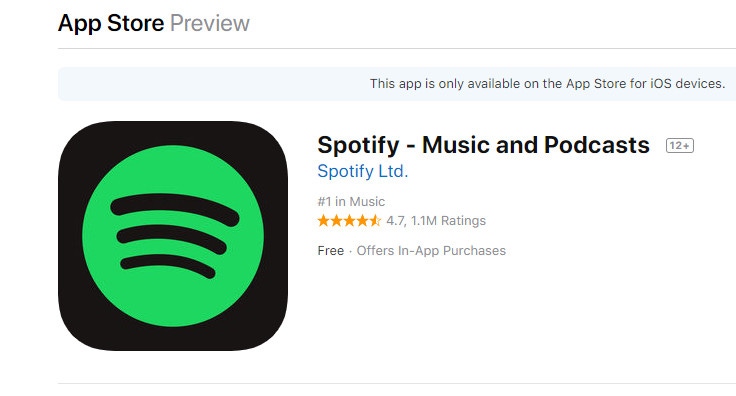Apple presented its side of the dispute with Spotify, claiming it is treating the latter equally as other apps and it is reasonable to charge 30% of premium payment to apps.
March 15, 2019

Apple has presented its side of the dispute with Spotify, claiming it is treating the latter the same as other apps and it is reasonable to charge 30% of premium payment to apps.
Shortly after Spotify filed a claim at the EU against Apple for being discriminated by the latter’s App Store rules and practices, Apple released a statement to deny these claims and throw the accusations back at Spotify.
Apple argued for the 30% charge of premium paid to apps on App Store platform with a few justifications. “Apple connects Spotify to our users. We provide the platform by which users download and update their app. We share critical software development tools to support Spotify’s app building. And we built a secure payment system — no small undertaking — which allows users to have faith in in-app transactions,” the statement said. Apple also hastened to add that Spotify has left out the part of the policy that the revenue share will drop to 15% from the second year on.
On Spotify’s argument that Apple has restricted payment methods to Apple’s own payment system only, Apple retorted that it demands all “digital goods and services that are purchased inside the app using our secure in-app purchase system”.
There are a few layers in the reading of the attrition when each side is only talking its own side’s truth, but there are also bigger questions related to the whole digital economy. There are minor inconsistencies in Apple’s statement, for example it claimed that Spotify has made “substantial revenue that they draw from the App Store’s customers”, only to contradict a few lines below by playing down the App Store’s significance by saying “only a tiny fraction of their subscriptions fall (sic.) under Apple’s revenue-sharing model.” And there is no need for Apple to use the dubious accusation that Spotify is suing music creators. They (Spotify, Google, Pandora, Amazon) are not. They are appealing to overturn a court decision to increase royalty payment by 44%.
There is as much left unsaid as said. For example, Apple failed to address Spotify’s concern that Apple is both operating a platform and distributing its own competing products, in this case Apple Music. This was a point brought up in a conversation The Verge had with Sen. Elizabeth Warren, who did not include Apple in her first list of companies to “break up”. “It’s got to be one or the other,” Warren told The Verge referring to Apple. “Either they run the platform or they play in the store. They don’t get to do both at the same time.” This resonates with Spotify’s accusation that Apple is being both the referee and a player.
It also does not give out the reason why Spotify, or any apps, should not have the option to handle payments within the app with alternative but equally safe payment system (e.g. credit cards).
Then there is the broader question whether app stores should be allowed to collect a commission fee for apps distributed on its platform. Technically Apple, and other applications stores like Google’s Play Store, could argue that they are a distribution channel and a retail outlet. Like other channels and retailers, they must be able to charge a fee to sell the products. This side of the business would not be so significant for Apple earlier, as it was mainly using the app ecosystem to sell, and lock consumers in, iPhones. It is getting more meaning for the company now that the iPhone sales are slowing down while “Services” has become a meaningful part of the business. That is also a key reason why both Apple and Google are actively encouraging apps to move to subscription model to generate recurring income for the platforms.
But there has never been any justification why the fee should be as high as 30%, and Apple and Google have been well synchronised with their charge level (as well as halving the fee from second year onward). This has become a significant additional cost for the app developers. Some with deeper pockets could absorb the cost and keep the retail price similar to other platforms (e.g. The Economist magazine). Those businesses operating on thin margin or on a loss have to move the additional cost to users who opt to pay for the premium inside the app (e.g. Spotify). Other businesses simply choose to disable the option to upgrade to premium inside their iOS app to avoid the fee (e.g. the Financial Times newspaper).
Apple used Spotify’s partnerships with carriers as a supporting argument for the charge, saying “a significant portion of Spotify’s customers come through partnerships with mobile carriers… (which) requires Spotify to pay a similar distribution fee to retailers and carriers.” This may or may not be true as each carrier deal with OTT services is different. Even if this is accurate, mobile carriers most likely are following the Apple’s and Google’s benchmark rather than the other way round.
About the Author(s)
You May Also Like








.png?width=300&auto=webp&quality=80&disable=upscale)


_1.jpg?width=300&auto=webp&quality=80&disable=upscale)


.png?width=800&auto=webp&quality=80&disable=upscale)